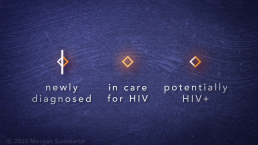Master’s Thesis
Visualizing HOPE:
Encouraging HIV-Positive Organ Transplantation Using Novel Modular Animations
My thesis explored creating segmented animations that efficiently communicate information to audiences with different levels of expertise (e.g., patient versus healthcare provider). The resulting animations consisted of a reusable background information clip followed by individualized calls-to-action to address multiple groups of people and encourage participation in HIV-to-HIV transplantation.
A full PDF of my thesis can be viewed here.








Abstract
HIV+ candidates in need of organ transplantation face an increased risk of mortality while on the organ waitlist and decreased access to transplantation compared to HIV-uninfected (HIV-) candidates. Fortunately, HIV+ donor organs can now legally be transplanted into HIV+ recipients, thanks to the HIV Organ Policy Equity (HOPE) Act of 2013, which reverses an outdated ban and unlocks a pool of organs from an estimated 300-500 HIV+ deceased donors in the US annually. However, challenges in the current organ donation system and stigma against HIV present barriers to HOPE implementation and the potential for life-saving HIV+ donor to HIV+ recipient (HIV-to-HIV) organ transplantation. In collaboration with transplant surgeons, infectious disease healthcare providers, organ donation community consultants, and medical illustrators, a novel animation workflow was developed to create HOPE education materials. The animations, targeted to potential donors and recipients with HIV, healthcare providers, and professionals in the organ donation community are intended to promote awareness and ultimately increase the rate of HIV-to-HIV transplantation.
To efficiently communicate to these critical audiences, the animation process was streamlined by combining overlapping information into reusable components and addressing each audience with a customized call-to-action clip. The results of this project provide two individual animations addressed to (1) people living with HIV and (2) professionals in the organ donation community. The animations consist of reusable clips that explain the background information of the HOPE Act, the potential biological risks of HIV-to-HIV transplantation, and a concluding statement that reminds the viewer that their participation is essential to continue the success of the HOPE Act. Each animation concludes with an individualized call-to-action segment that inspires viewers to make a change.

By informing these critical audiences through inclusive and educational animations, this project aims to reduce stigma in HIV+ organ donor referrals and registration and to encourage participation in HIV-to-HIV transplantation.
1 - People Living with HIV
This animation is expected to encourage people living with HIV to consider registering to be organ donors to increase rates of lifesaving HIV-to-HIV transplantation.
2 - HIV+ Organ Donor Referrals and Screenings
This animation is expected to reduce HIV stigma in organ donor referrals by nurses at hospitals with trauma centers, and in organ donor screening by Organ Procurement Organization representatives.
